Stirrup - from Wikipedia
A stirrup is a light frame or ring that holds the foot
of a rider, attached to the saddle by a strap, often called a stirrup leather.
Stirrups are usually paired and are used to aid in mounting and as a support
while using a riding animal (usually a horse or other equine, such as a
mule). They greatly increase the rider's ability to stay in the saddle
and control the mount, increasing the animal's usefulness to humans in
areas such as communication, transportation and warfare.
In antiquity, the earliest foot supports consisted of
riders placing their feet under a girth or using a simple toe loop. Later,
a single stirrup was used as a mounting aid, and paired stirrups appeared
after the invention of the treed saddle. The stirrup was invented in China
in the first few centuries AD and spread westward through the nomadic peoples
of Central Eurasia. The use of paired stirrups is credited to the Chinese
Jin Dynasty and came to Europe during the Middle Ages. Some argue that
the stirrup was one of the basic tools used to create and spread modern
civilization, possibly as important as the wheel or printing press.
Modern stirrups come in a wide variety of styles, sizes
and materials and are attached to most saddles by means of adjustable stirrup
leathers, which can be altered in length to fit both the size of the rider
and the need to remain over the horse's optimal center of balance for a
given equestrianism discipline. There are safety concerns associated with
the use of stirrups, including a risk that a fallen rider may get their
foot caught in the stirrup and be dragged by the horse, or that long hours
of use without rest may cause problems in the human foot's Peroneus Tertius
tendon. Stirrups are safer to use when riding boots are worn, and proper
sizing and placement of the foot on the stirrup increases both safety and
usability.
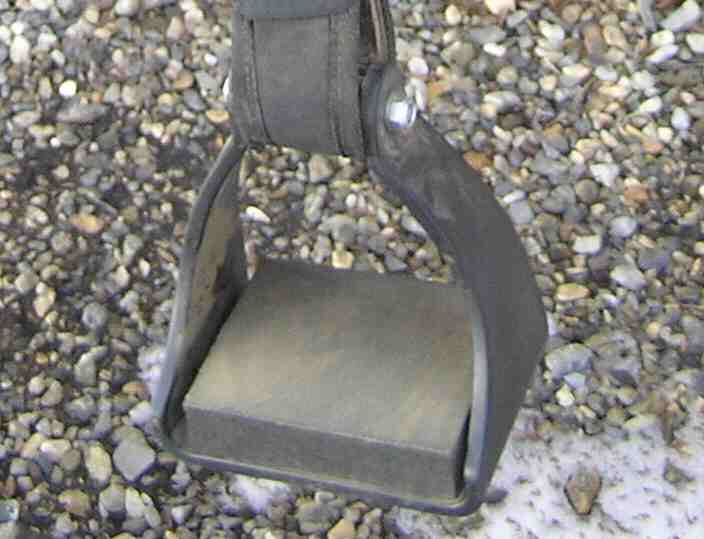
A modern working stirrup on an
endurance riding saddle. |
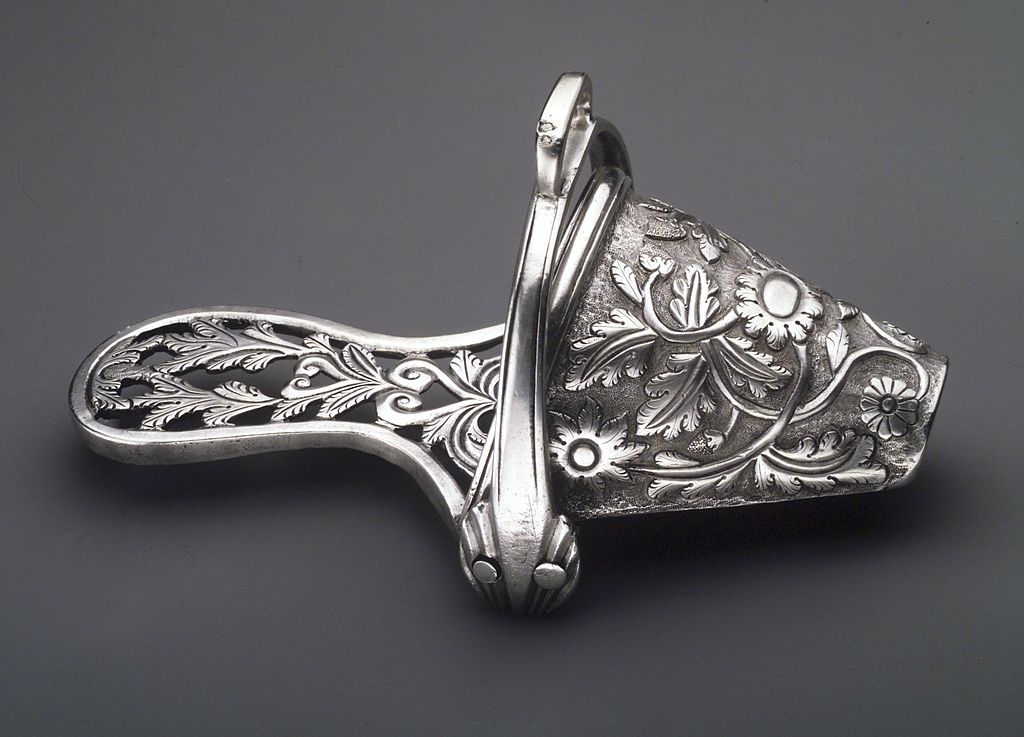
Lady's Stirrup, late 18th -19th century. |
Etymology
The English word "stirrup" stems from Old English stirap,
stigrap, Middle English stirop, styrope, i.e. a mounting or climbing-rope.
From Old English st?gan "to ascend", which might have origins in the Sanskrit
word "sthagan" ("stay put").
History
The stirrup, which gives greater stability to a rider,
has been described as one of the most significant inventions in the history
of warfare, prior to gunpowder. As a tool allowing expanded use of horses
in warfare, the stirrup is often called the third revolutionary step in
equipment, after the chariot and the saddle. The basic tactics of mounted
warfare were significantly altered by the stirrup. A rider supported by
stirrups was less likely to fall off while fighting, and could deliver
a blow with a weapon that more fully employed the weight and momentum of
horse and rider. Among other advantages, stirrups provided greater balance
and support to the rider, which allowed the knight to use a sword more
efficiently without falling, especially against infantry adversaries. Contrary
to common modern belief, however, it has been asserted that stirrups actually
did not enable the horseman to use a lance more effectively (cataphracts
had used lances since antiquity), though the cantled saddle did.
Precursors
The invention of the stirrup occurred relatively late
in history, considering that horses were domesticated in approximately
4500 BC, and the earliest known saddle-like equipment were fringed cloths
or pads with breast pads and cruppers used by Assyrian cavalry around 700
BC.
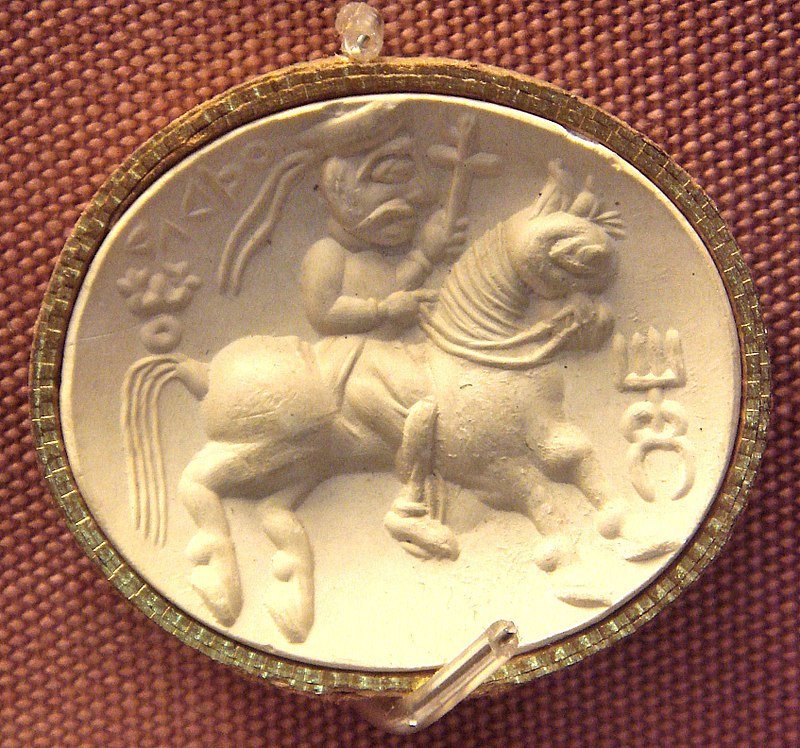
Depiction of a Kushan divinity using an early
platform-style stirrup, circa AD 150. British Museum. |
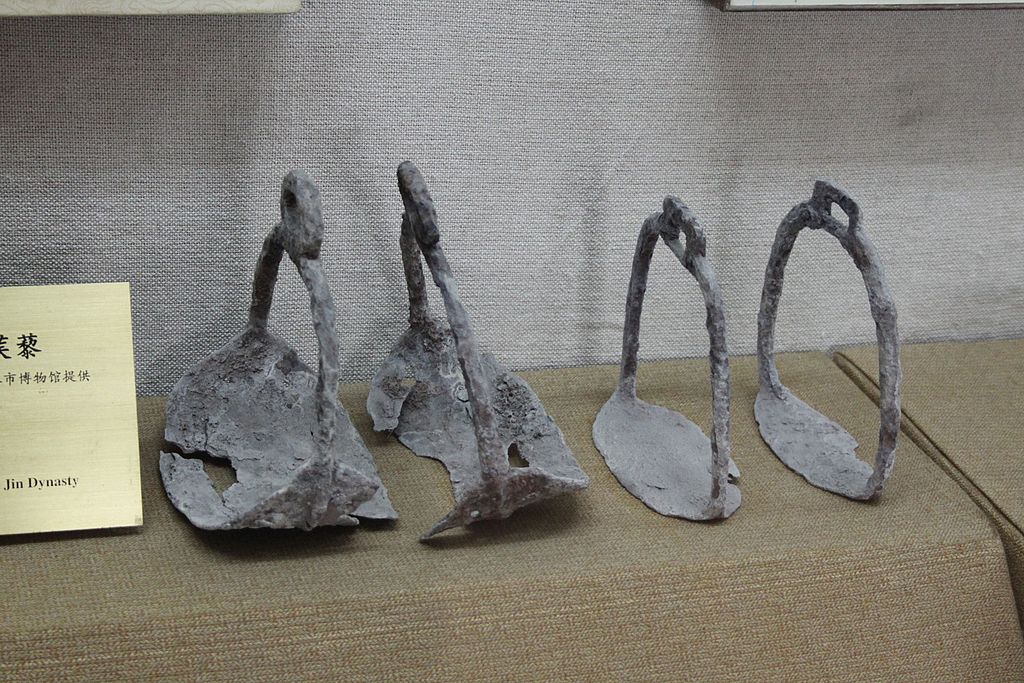
Jin (AD 265-420 ?) iron stirrups, AD 415. |
The earliest manifestation of the stirrup was a toe loop
that held the big toe and was used in India late in the second century
BC, though may have appeared as early as 500 BC. This ancient foot support
consisted of a looped rope for the big toe which was at the bottom of a
saddle made of fibre or leather. Such a configuration was suitable for
the warm climate of south and central India where people used to ride horses
barefoot. A pair of megalithic double bent iron bars with curvature at
each end, excavated in Junapani in the central Indian state of Madhya Pradesh
have been regarded as stirrups although they could as well be something
else. Buddhist carvings in the temples of Sanchi, Mathura and the Bhaja
caves dating back between the 1st and 2nd century BC figure horsemen riding
with elaborate saddles with feet slipped under girths. In this regard archaeologist
John Marshall described the Sanchi relief as "the earliest example by some
five centuries of the use of stirrups in any part of the world". Later,
a single stirrup was used as a mounting aid by a nomadic group known as
the Sarmatians.
The invention of the solid saddle tree allowed development
of the true stirrup as it is known today. Without a solid tree, the rider's
weight in the stirrups creates abnormal pressure points and make the horse's
back sore. Modern thermography studies on "treeless" and flexible-tree
saddle designs have found that there is considerable friction across the
center line of a horse's back. A coin of Quintus Labienus, who was in service
of Parthia, minted circa 39 BC depicts on its reverse a saddled horse with
hanging objects. Smith suggests they are pendant cloths, while Thayer suggests
that, considering the fact that the Parthians were famous for their mounted
archery, the objects are stirrups, but adds that it is difficult to imagine
why the Romans would never have adopted the technology.
In Asia, early solid-treed saddles were made of felt that
covered a wooden frame. These designs date to approximately 200 BC
One of the earliest solid-treed saddles in the west was first used by the
Romans as early as the 1st century BC, but this design also did not have
stirrups.
China
The first dependable representation of a rider with paired
stirrups was found in China in a Jin Dynasty tomb near Nanjing dated approximately
about AD 322; an earlier representation of a single mounting stirrup was
found in a tomb figuring near Changsha that dated to AD 302. The stirrup
appeared to be in widespread use across China by AD 477.
Japanese stirrups
| Stirrups (abumi) were used in Japan as early as the 5th
century. They were flat bottomed rings of metal-covered wood, similar to
European stirrups. The earliest known examples were excavated from tombs.
Cup-shaped stirrups (tsuba abumi) that enclosed the front half of the rider's
foot eventually replaced the earlier design.
During the Nara period, the base of the stirrup which
supported the rider's sole was elongated past the toe cup. This half-tongued
style of stirrup (hanshita abumi) remained in use until the late Heian
period when a new stirrup was developed. The fukuro abumi or musashi abumi
had a base that extended the full length of the rider's foot and the right
and left sides of the toe cup were removed. The open sides were designed
to prevent the rider from catching a foot in the stirrup and being dragged.
The military version of this open-sided stirrup (shitanaga
abumi) was in use by the middle Heian period. It was thinner, had a deeper
toe pocket and an even longer and flatter foot shelf. This stirrup stayed
in use until European style-stirrup rings were reintroduced in the late
19th century. It is not known why the Japanese developed this unique style
of stirrup. These had a distinctive swanlike shape, curved up and backward
at the front so as to bring the loop for the leather strap over the instep
and achieve a correct balance. Most of the surviving specimens from this
period are made entirely of iron, inlaid with designs of silver or other
materials, and covered with lacquer. In some examples there is an iron
rod from the loop to the footplate near the heel to prevent the foot from
slipping out. The footplates are occasionally perforated to let out water
when crossing rivers, and these types are called suiba abumi. There are
stirrups with holes in the front forming sockets for a lance or banner. |
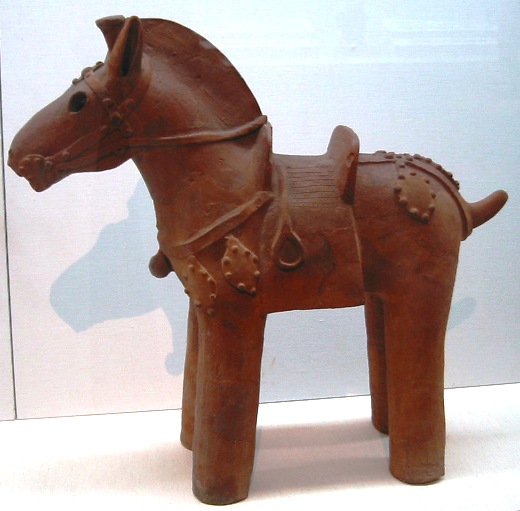
Haniwa horse statuette, complete with saddle
and stirrups, 6th century, Kofun period, Japan. |
Stirrups in Europe
By the late 6th or early 7th century AD, primarily due
to invaders from Central Asia, such as the Avars, stirrups began spreading
across Asia to Europe from China. In terms of archaeological finds, the
iron pear-shaped form of stirrups, the ancestor of medieval European types,
has been found in Europe in 7th century Avar graves in Hungary. A total
of 111 specimens of early Avar-age, apple shaped, cast-iron stirrups with
elongated suspension loop and flat, slightly inward bent tread had been
excavated from 55 burial sites in Hungary and surrounding regions by 2005.
The first European literary reference to the stirrup may be in the Strategikon,
traditionally ascribed to the Byzantine Emperor Maurice, and therefore
written sometime between 575 and 628, but this is widely disputed, and
the work is placed in the eighth or ninth century by others. Maurice's
manual notes the appropriate equipping of Imperial cavalry: "the saddles
should have large and thick clothes; the bridles should be of good quality;
attached to the saddles should be two iron steps [skala], a lasso with
a thong...." Dennis notes that the lack of specific Greek word for
stirrup evidences their novelty to the Byzantines, who are supposed to
have adopted these from their bitter enemy the Avars, and subsequently
passed them on to their future enemies, the Arabs. An early 7th-century
date is secured for most Hungarian finds of stirrups with elongated suspension
loops, though some of these must even be dated to before 600. Literary
and archaeological evidence taken together may indicate that the stirrup
was in common military use in South-Central Europe and the Eastern Mediterranean
by the latter half of the 6th century, with the Byzantine Empire having
them in use by the year 600.
By the 8th century stirrups began to be adopted more widely
by Europeans. The earliest stirrups of western Europe, those of Budenheim
and Regensburg, were either brought from the Avar Khaganate as booty or
gifts, or were local imitations of stirrups in use at that time among Avar
warriors. However, the Avar-style stirrups were not as widely adopted in
western Europe. Stirrups do not appear in the Merovingian and Italo-Lombard
milieu in large numbers, nor as frequently as within the Carpathian Basin.
Most other stirrups found in Germany that date to the 7th century do not
resemble the iron Avar style commonly found in burial assemblages from
Hungary and neighboring regions. Instead, hanging mounts occasionally found
in burial assemblages in southern Germany suggest the use of wooden stirrups.
The scarcity of early-medieval stirrup finds in western Europe was noted
by Bernard Bachrach: "Out of 704 eighth century male burials excavated
in Germany until 1967, only 13 had stirrups."
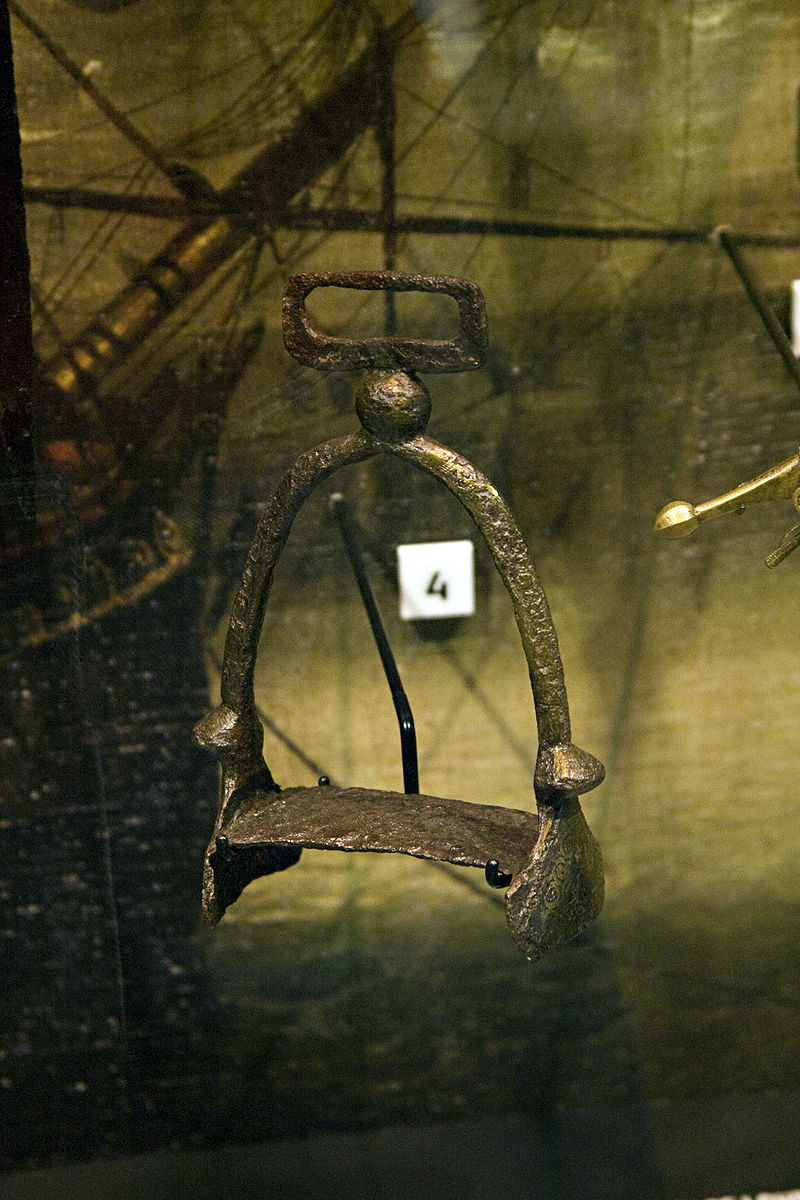
10th century stirrup found in England. |
The earliest stirrups in the Baltic region are replicas
of those in existence in Germany during the 7th century. In northern Europe
and Britain the metamorphosis of earlier wood, rope and leather forms of
stirrups to metal forms can be seen in the archeological record, “suggesting
that one or more of the early forms have parallel development with those
in Hungary, rather than being derived solely from the latter region.” "In
Scandinavia two major types of stirrups are discerned, and from these,
by the development and fusion of different elements, some almost certainly
of central European origin, most other types were evolved." The first main
type, Scandinavian type I, appears to owe little to Hungarian forms. The
earliest variety of this type can be dated to the 8th century in Vendel
grave III in Sweden. The second principal type in North Europe has, as
its most characteristic feature, a pronounced rectangular suspension loop
set in the same plane as the bow, as found amongst the Hungarian examples,
and is predominantly centered in Denmark and England during the later 10th
and 11th centuries. A variant of this type, called the North European stirrup,
has been dated to the second half of the 10th century in Sweden, found
at the boat-burial cemetery at Valsgärde.
In Denmark from the 920s to the 980s, during the reign
of the Jelling kings, many leading Danes were buried with military honors
and equipped with stirrups, bits and spurs, in what are called cavalry-graves,
found mostly in north Jutland. Into England, it is argued, stirrups were
not introduced by the Scandinavian settlers of the 9th century but are
more likely related to later Viking raids led by Cnut the Great and others
during the reign of king Aethelred (978-1013).
In what today is France, Charles Martel distributed seized
lands to his retainers on condition that they serve him by fighting in
the new manner, which some attribute to his recognizing the military potentialities
of the stirrup. Later, Charlemagne ordered his poorer vassals to pool their
resources and provide a mounted and armed knight, though the system proved
unworkable, and instead the system of distributing land to vassals based
on a knight's service was developed. |
Great Stirrup Controversy
The introduction of the stirrup not only made the mounted
warrior supreme in medieval warfare, but may have initiated complex and
far-reaching social and cultural changes in Europe. Some scholars credit
the birth of feudalism and its subsequent spread into Northern Italy, Spain,
Germany and into the Slavic territories to this use of the stirrup. It
is argued that the rising feudal class structure of the European Middle
Ages derived ultimately from the use of stirrups: "Few inventions have
been so simple as the stirrup, but few have had so catalytic an influence
on history. The requirements of the new mode of warfare which it made possible
found expression in a new form of western European society dominated by
an aristocracy of warriors endowed with land so that they might fight in
a new and highly specialized way."
Other scholars dispute this assertion, suggesting that
stirrups may provide little advantage in shock warfare, but are useful
primarily in allowing a rider to lean farther to the left and right on
the saddle while fighting, and simply reduce the risk of falling off. Therefore,
it is argued, they are not the reason for the switch from infantry to cavalry
in medieval armies, nor the reason for the emergence of Feudalism.
Stirrup leathers
Because a rider must be able to move his or her legs
while riding, stirrups cannot be attached on the body of the saddle itself,
but rather must be attached in a manner that allows the rider's leg a full
range of motion. Therefore, stirrups are attached to a saddle by means
of adjustable straps, called stirrup leathers. Depending on the design
of a saddle, stirrup leathers may be attached to a "stirrup bar," a small
forged steel bar embedded into the saddle tree, or may be wrapped around
the bars of the tree itself. Because different riders are of different
heights, and stirrups also may need to be adjusted up or down to accommodate
different types of activity, stirrup leathers have buckles and holes that
allow length to be adjusted.
On an English saddle, leathers are quite thin, only about
one inch wide. On a western saddle, they are very heavy, three to four
inches wide on the side closest to the horse, and even wider, expanded
into a decorative "fender" on the outside (which also protects the rider's
legs from the sweat of the horse). Stirrup leathers on other saddle designs
fall in between the extremes represented by the English and western saddles.
Stirrup leathers are usually manufactured so that the
smooth side of the leather faces the wearing surface, as the smooth side
wears less quickly than the rough side. There are also modern alternatives
to leather, including nylon, plastic covered nylon (biothane being one
example) or leather over a nylon reinforced core. These new "leathers"
may last longer and also resist stretching. On the other hand, they may
chafe and rub the leg, and poorly made products may break more easily than
leather.
As the rider's whole weight must be carried at one side
when mounting, on an English saddle, one stirrup leather often becomes
stretched longer than the other, usually the left one, because most mounting
occurs on that side. While a simple adjustment of the leather can even
up the stirrups, to preserve the integrity and longevity of the leathers,
they should be switched to the opposite sides from time to time. On a western
saddle, with a heavier, permanently installed fender and stirrup leather
that cannot be switched, stretching is slower and less extreme, though
it also occurs in this type of saddle. Any unevenness in the leathers can
be managed by adjusting the stirrup length, and if necessary, by adding
extra holes in the leathers to allow them to be buckled at an intermediate
point between the existing prepunched holes provided by the saddle manufacturer.
Adjustment and uses of stirrups
| There are two basic methods of using stirrups, a shorter
stirrup to allow more mobility and a longer stirrup to allow greater control.
The stirrup itself is similar, but the length of the stirrup leather is
different. In each case, the stirrup length allows the rider to remain
over the center of balance of the horse for the average speed characteristic
of the discipline; the faster the horse travels, the more forward the rider
must be positioned, and hence the shorter the stirrup.
Long stirrups allow the rider to ride with a long leg,
with the knee relaxed and only slightly bent, allowing a deep and stable
seat in the saddle. When riding a long stirrup, the rider has excellent
control of the horse and the greatest ability to feel and communicate with
the horse via the riding aids. This provides a sturdy base for activities
where precision is required or when the rider is at risk of being unseated.
For both reasons, long stirrups were thus the choice of heavy cavalry such
as the medieval knights, who fought in close quarters and used weapons
such as the lance and long, heavy swords. Historically, this type of stirrup
adjustment and the riding seat it produced was called la brida. Today it
is the choice for dressage and many types of western riders.
Shorter stirrups require a rider to keep the knees bent
at a greater angle. When riding in a short stirrup, the rider has the ability
to partially stand up and get the seat clear of the saddle. This allows
more mobility than a longer stirrup would, but at the cost of having less
feel of the horse and less security. It is a position designed to help
the horse achieve greater speed, and also allows the rider greater physical
mobility in the saddle. When riding with short stirrups, the rider often
adopts what is known as a forward seat, thus inhibiting the horse's balance
and athletic maneuverings as little as possible. In the past, this style
was preferred by light cavalry. These fighters required speed and needed
the flexibility to turn their own bodies in any direction to use light
weapons such as the bow, javelin, short swords, and later, the rifle and
pistol. The horsemen of Central Asia, such as the Mongols, used this type
of stirrup, as did the Islamic Bedouin and Moors of the Middle East and
North Africa. Historically, this type of stirrup adjustment and the seat
it produced was called la jineta. Modern Jockeys, eventers, and show jumping
riders use this type of stirrup, as do some cowboys when performing certain
jobs that require a forward position to allow agility of horse and rider,
such as calf roping
While an inexperienced rider may feel more secure with
a slightly too-short stirrup, in reality, it is actually easier to be thrown
from the horse because the rider's legs act as a |
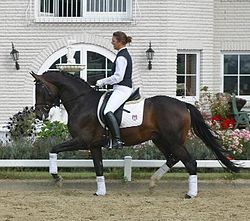
The long stirrups of the dressage rider
allow for a long leg, thus giving the greatest
amount of communication
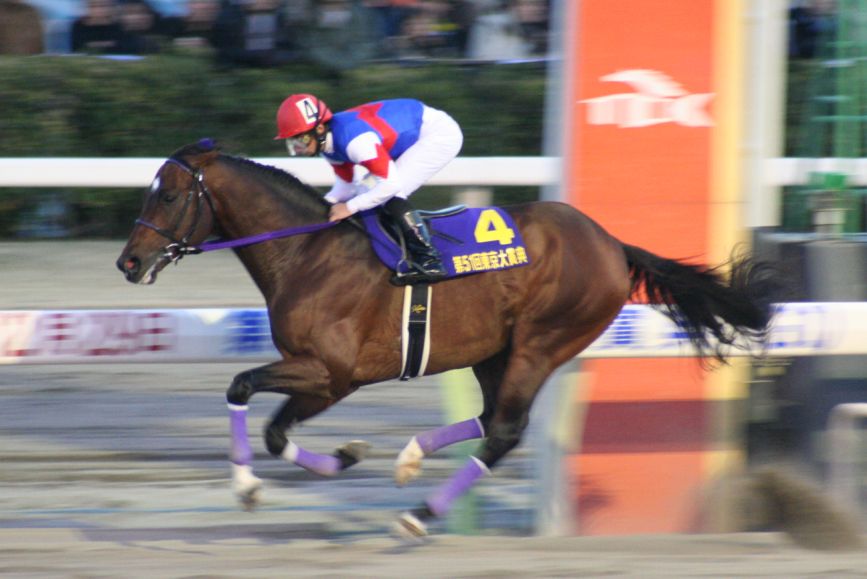
The short stirrups of a jockey allow the rider to stay
over the galloping horse's center of
balance and allow the horse to reach the
maximum possible speed |
stabilizing agent, much in the same way the long pole
of a tightrope walker balances the acrobat. Obviously, a stirrup leather
so long that a rider cannot reach it is useless, and a stirrup length that
does not allow a rider with a properly positioned leg to keep the heel
lower than the toe is also easily lost. However, shortening the stirrup
until the rider feels they will not lose the stirrup is counterproductive;
the goal of correct equestrianism is to make maximum use of the leg. Lengthening
the leg creates a more secure seat, while shortening the stirrup is done
only to accommodate the needs of the horse to perform athletic movement.
Thus correct stirrup length creates a balance between control and mobility
that fits the discipline performed.
There are a spectrum of stirrup lengths, which the rider
may chose depending on the purpose. For example, in dressage, the longest
possible stirrup length is used in order for the rider to have complete
control over every nuance of the horse's movement. Likewise, a very long
stirrup is used in the western sport of cutting, where, though the rider
relinquishes control to the horse, requires maximum security to stay in
the saddle during the rapid stops, turns and bursts of speed the horse
uses when maneuvering cattle. For a comfortable ride over long hours at
slow speeds, the long stirrup is also preferred by trail riders.
Riders jumping low fences may wish for an intermediate
length stirrup that can allow the horse some freedom of movement, while
supporting the rider over the fence, and still providing enough leg for
excellent communication. A rider travelling rapidly cross-country, over
varying terrain while fox hunting or endurance riding, will also have an
intermediate stirrup, needing to strike a compromise between mobility for
the horse and the need of the rider to not be unseated. In the western
rodeo sport of calf roping, a moderately short stirrup is also required
to help the horse to sprint quickly from the box, and to allow the cowboy
the freedom to swing a lariat.
A show jumping rider will have a shorter stirrup than
other English riders, in order to maximize the jumping effort of the horse.
However, the rider also has the challenge of staying on over the fence
and controlling the horse through rapid changes of pace and direction,
so still needs some length of leg for stability.
Jockeys must be completely off their horse's backs, balanced
well forward over the withers, to allow their mount optimum speed in a
long, galloping stride. Therefore, they have the shortest possible stirrup
length. The cost for maximum speed is minimum control and security. Jockeys
must be in superb muscular condition and possess outstanding balance; they
cannot achieve the finesse of leg aids needed in other equestrian sports,
and must rely primarily on the use of their seat and a crop for speed,
and on their arm strength for directional control or slowing down. Their
relative lack of control is clearly demonstrated by the use of "pony" horses
to lead the race horse and jockey to the track, the use of assistants at
the starting gate to load the horses, and the availability of outriders
(all with much longer stirrups) to assist the jockey at the end of a race
or in the event of an accident. If the horse does anything but run in essentially
a straight line with long gradual curves, or if anything goes seriously
wrong, jockeys can easily be thrown, as their high rate of injury so amply
illustrates.
Weaknesses in design
The stirrup design does have two inherent design flaws.
The first is a safety issue: even with a properly fitted stirrup, there
are several ways in which the rider's foot can be trapped and cause the
rider to be dragged in the event of a fall from the horse. The second is
the potential negative impact on the health of the human foot.
One reason riders can become hung up is due to improper
stirrup sizing. If the stirrup is too large, the foot can go through the
stirrup opening and be caught. If the stirrup is too small, the foot can
become trapped more easily as the foot cannot free itself. The main reason
for a rider to become hung up in the irons is due to the 'closing door
effect' of a lost stirrup trying to return to lie flat against the side
of the horse. When the rider falls and the stirrup is free, it tends to
return to its home position flat against the horse's side. As the stirrup
returns to the horse, the opening for the foot gets smaller and smaller
and can catch a falling rider's boot in that smaller opening.(see Fitting
the stirrup, below). Proper stirrup placement, on the ball of the foot,
instead of jammed "home" clear up to the arch, also lowers the risk of
a rider being dragged.
Modern English saddles are designed with a stirrup bar
that allows the stirrup leathers to fall from the saddle if the rider starts
to be dragged. Some English stirrups are also designed with breakaway sides
or non-standard designs intended to make it easier for the foot to come
out of the stirrup when necessary.
Western saddles have significantly wider stirrups, particularly
at the tread, to minimize this risk. Sometimes, they are equipped with
tapaderos, leather covers over the toe that close each stirrup from the
front. A tapadero prevents the rider's boot from slipping through and also
prevents brush encountered while working cattle on the open range from
poking through the stirrup, injuring or impeding the horse or rider. However,
the tapadero is not common in modern times and is not allowed in most show
competition.
The second design flaw of the stirrup affects the health
of the human foot. The rider's whole weight is at times supported entirely
by the stirrups. During these periods, excessive pressure can be exerted
on the peroneus tertius tendon, which runs along the lateral side of the
foot. In extreme cases, stirrups have been found to cause damage to the
tuberosity of the fifth metatarsal bone. Over long periods of extreme use,
this can cause various medical conditions ranging from simple impaired
walking to severe pronation or supination of the foot. Normal riders, however,
generally have no related problems, even over a lifetime of riding. Disciplines
that require long hours in the saddle, such as endurance riding and some
types of western riding on a working ranch, often use a wider stirrup to
provide more support to the foot.
For the comfort of the horse, all stirrups require that
the saddle itself be properly designed. The solid tree of the saddle distributes
the weight of the rider over a greater surface area of the horse's back,
reducing pressure on any one area. If a saddle is made without a solid
tree, without careful engineering, the rider's weight in the stirrups and
leathers can create pressure points on the horse's back and lead to soreness.[17][50]
This is especially noticeable with inexpensive bareback pads that add stirrups
by means of a strap across the horse's back with a stirrup at each end.
Riding boots
The risk of being dragged by a foot caught in the stirrup
spawned an adaptation in riding footwear: Riding boots have a raised heel
of at least a half-inch, and in special designs like the western cowboy
boot, often more. This "ridge" created by the raised heel will usually
catch on the bottom of the stirrup, preventing the foot from slipping through
the stirrup and dragging the rider. Riding boots also have a smooth sole
that can easily slide in and out of the stirrup.
Footwear such as a tennis shoe or a hiking boot is considered
inappropriate for riding both because the shoe has little or no raised
heel and because the heavy tread that provides traction for athletic endeavors
can cause the foot to catch in the stirrup and become trapped. Modern synthetic
materials have allowed the design of riding boots that will slide from
a stirrup but are also comfortable for walking, with a sole using varying
hard and soft materials that provides reasonable traction with a minimal
amount of raised tread.
Modern stirrups
The modern stirrup can be made from a variety of materials
including metals, wood and certain synthetics. Stirrups with a wider tread
tend to be more comfortable and a rider is less likely to become hung up
in the event of a fall. Thinner stirrups provide greater security. Though
the underlying design of a flat bottom and curved top have not significantly
changed from the earliest artifacts, some modifications have made the stirrup
safer and more comfortable.
One of the most dangerous problems with the stirrup is
that the rider can get a boot stuck in it in the event of a fall, which
would result in the person being dragged. Several different designs have
been developed to allow the stirrup to break away, fall off or easily release
the foot if the rider falls. Other modern stirrup designs have changed
the angle or orientation of the tread, either permanently or by added hinges,
supposedly to help the rider flex the ankle and get weight into the heels.
Other experimental improvements have included a swivel feature at the top
of the leather to keep the stirrup turned out to face the rider's foot.
English-style stirrups
| Stirrups used on English saddles are usually made of
metal. Though called "irons," they are no longer made of iron, as a rule,
but instead stainless steel is the metal of choice, due to its strength,
though when weight is an issue, such as for a jockey, they may also be
made of aluminum. Inexpensive stirrups may be made of nickel, which can
easily bend or break and should be avoided. Stirrups may also be made of
synthetic materials and various metallic alloys. There are many variations
on the standard stirrup design, most claiming to either be safer in the
event of a fall or to make it easier for a rider to maintain a proper foot
and leg position.
Some variations include:
Standard iron: The most common stirrup iron, consisting
of a tread, with two branches, and an eye at the top for the leather to
run through. The main styles seen today include:
Fillis:
A design with a heavy tread, and branches that rise to the eye in a rounded
triangular shape.
Prussian:
A rounder and lighter design.
Safety stirrups. There are
a number of designs intended to release the foot more easily in
the event of a fall. One style has
an outside branch that is curved, rather than straight.
Other designs feature a breakaway
outer branch which will detach with sufficient
pressure, freeing the foot.
Side-saddle stirrups: usually
have a slightly larger eye to accommodate the thicker
stirrup leather on a sidesaddle.
Other designs: have joints
or hinges in the branches of the stirrups to allow for them
to flex. However, one model was recalled
in 2007 due to a tendency for the hinges to
break. A variation on the hinged stirrup
is the Icelandic Stirrup, which has the eye
fixed at a 90 degree rotation to allow
for less stress on the tendons, and easier
retrieval should a stirrup be lost.
There are a number of other patented designs with
various features that are usually
intended to either increase comfort or to assist
proper foot position. |
Western-style stirrups
The stirrup of a western saddle is more difficult to remove
or replace than the English stirrup and therefore, unless damaged or a
different style is desired, the same stirrups usually are kept on for the
life of the saddle itself. The tread is mostly flat, but may be curved
at the sides to some degree. The branches are wide at the bottom and narrow
at the top, where they are joined by a heavy dowel of wood, or rod of metal.
The stirrup leather loops under the rod and a "keeper," a strap with a
buckle that wraps around the front and back of the stirrup leather, keeps
the stirrup in place. Western stirrups are generally made of leather-covered
wood, others of steel, aluminum, or even very strong fiber-reinforced plastic.
Western stirrups are designed to parallel the use intended
by the design of the saddle itself; a trail riding saddle will have a wide,
comfortable stirrup, a saddle for saddle bronc riding will have a narrow
tread, to avoid being easily lost by the rider. A saddle for barrel racing
or reining will have stirrups of a medium width, narrow enough to not be
lost when a horse is moving at high speed, but with enough width to remain
comfortable for a few hours. Stirrups on a saddle intended for western
pleasure may be highly ornamented with silver. Stirrups on saddles used
by people who use horses for hunting game in the forest are sometimes made
of blaze orange for visibility to other hunters, and, because much big
game hunting in the American West takes place late in the year when it
is very cold, some "winter boot" designs are deliberately made extra large
with an especially smooth bottom so that a person can wear heavy winter
boots with a raised tread without as much risk of getting them caught up
in the stirrup. |
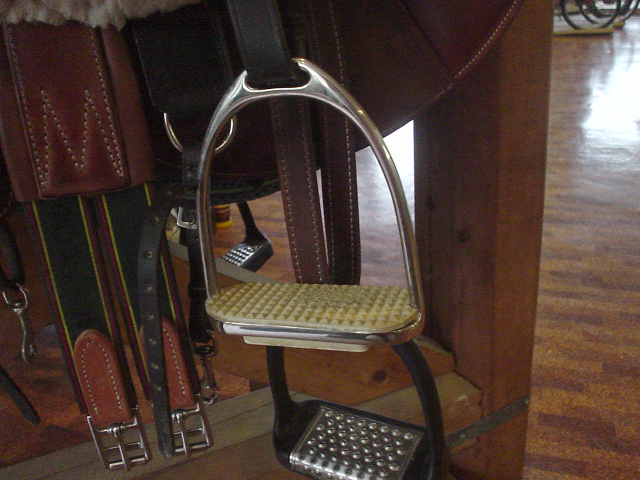
Modern fillis stirrup.
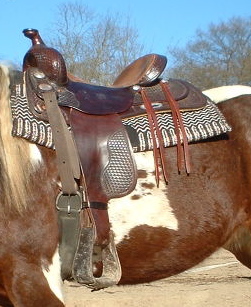
A Western saddle has wide stirrups and
heavy stirrup leathers |
Fitting the stirrup
It is very important that the stirrup be the correct width
for the boot. A stirrup that is too narrow will increase the chance that
the boot will get caught in it (which would be very dangerous should the
rider fall), and a too-wide stirrup makes it harder for a rider to keep
it under the foot, and presents some risk that the foot might slip all
the way through. It is generally suggested that the stirrup be no more
than 1 inch larger than the widest part of the sole of the rider's boots.
Additionally, the rider's boot should have a heel (both
English and Western-style riders).
Placement of the stirrup on the foot
In general, the stirrup is placed on the ball of the foot,
allowing the rider to let his weight flow down the back of the leg into
the heel by way of the flexible ankle. This provides the rider with the
support of the stirrup while still allowing for him to easily absorb the
shock of the horse's motion. If the stirrup is too far forward, on the
toes, the rider risks losing if he pushes with too much pressure (forcing
it off the foot) or too little (allowing it to simply slide off).
Some riders ride with the stirrup more "home," or shoved
toward the heel. This is seen most often in sports such as polo and eventing,
where the speed and sudden changes of direction of the former, and the
great change in terrain and solid fences of the latter, make the rider
more likely to be jarred loose from the saddle and increases the risk of
losing a stirrup. However, this placement actually puts the stirrup on
the arch of the foot, in a weaker position that leads to tension in the
leg, stiffness in the knee and decreases the flexibility of the ankle,
and therefore the shock-absorbing ability of the rider; paradoxically increasing
the risk of a fall. Additionally, it increases the chance that the rider's
foot will become stuck in the stirrup during a fall, a very dangerous situation.
This placement is often counterproductive and should not be used if it
is not an absolute necessity. The "home" position has some value in saddle
bronc riding, as a lost stirrup will almost inevitably result in the rider
being thrown from the bucking horse, but because riders are thrown from
the horse at a high rate even under normal circumstances, this event also
has a high rate of riders being hung up in their stirrups and injured in
the process.
|